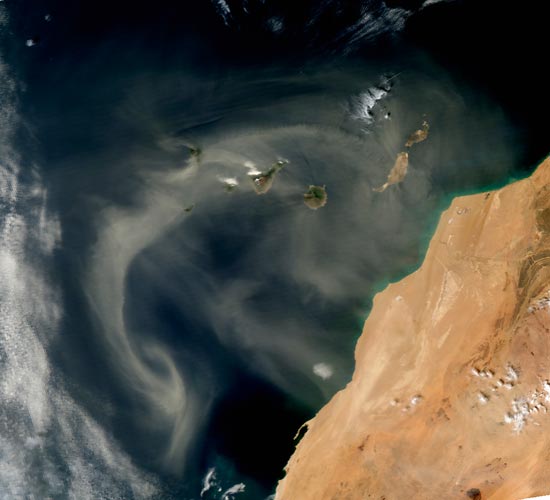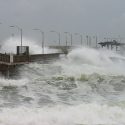Dust plays larger than expected role in determining Atlantic temperature
The recent warming trend in the Atlantic Ocean is largely due to reductions in airborne dust and volcanic emissions during the past 30 years, according to a new study.
Since 1980, the tropical North Atlantic has been warming by an average of a quarter-degree Celsius (a half-degree Fahrenheit) per decade. Though this number sounds small, it can translate to big impacts on hurricanes, which thrive on warmer water, says Amato Evan, a researcher with the University of Wisconsin–Madison’s Cooperative Institute for Meteorological Satellite Studies and lead author of the new study. For example, the ocean temperature difference between 1994, a quiet hurricane year, and 2005’s record-breaking year of storms, was just one degree Fahrenheit.

A dust storm off the coast of Morocco was imaged by NASA’s MODIS Aqua meteorological satellite on March 12, 2009. A new study by UW–Madison researcher Amato Evan shows that variability of African dust storms and tropical volcanic eruptions can account for 70 percent of the warming North Atlantic Ocean temperatures observed during the past three decades. Since warmer water is a key ingredient in hurricane formation and intensity, dust and other airborne particles will play a critical role in developing a better understanding of these storms in a changing climate.
Photo: courtesy Amato Evan
More than two-thirds of this upward trend in recent decades can be attributed to changes in African dust storm and tropical volcano activity during that time, report Evan and his colleagues at UW–Madison and the National Oceanic and Atmospheric Administration in a new paper. Their findings will appear in an upcoming issue of the journal Science and publish online today (March 26).
Evan and his colleagues have previously shown that African dust and other airborne particles can suppress hurricane activity by reducing how much sunlight reaches the ocean and keeping the sea surface cool. Dusty years predict mild hurricane seasons, while years with low dust activity — including 2004 and 2005 — have been linked to stronger and more frequent storms.
In the new study, they combined satellite data of dust and other particles with existing climate models to evaluate the effect on ocean temperature. They calculated how much of the Atlantic warming observed during the last 26 years can be accounted for by concurrent changes in African dust storms and tropical volcanic activity, primarily the eruptions of El Chichón in Mexico in 1982 and Mount Pinatubo in the Philippines in 1991.
In fact, it is a surprisingly large amount, Evan says. “A lot of this upward trend in the long-term pattern can be explained just by dust storms and volcanoes,” he says. “About 70 percent of it is just being forced by the combination of dust and volcanoes, and about a quarter of it is just from the dust storms themselves.”
The result suggests that only about 30 percent of the observed Atlantic temperature increases are due to other factors, such as a warming climate. While not discounting the importance of global warming, Evan says this adjustment brings the estimate of global warming impact on Atlantic more into line with the smaller degree of ocean warming seen elsewhere, such as the Pacific.
“This makes sense, because we don’t really expect global warming to make the ocean [temperature] increase that fast,” he says.
Volcanoes are naturally unpredictable and thus difficult to include in climate models, Evan says, but newer climate models will need to include dust storms as a factor to accurately predict how ocean temperatures will change.
“We don’t really understand how dust is going to change in these climate projections, and changes in dust could have a really good effect or a really bad effect,” he says.
Satellite research of dust-storm activity is relatively young, and no one yet understands what drives dust variability from year to year. However, the fundamental role of the temperature of the tropical North Atlantic in hurricane formation and intensity means that this element will be critical to developing a better understanding of how the climate and storm patterns may change.
“Volcanoes and dust storms are really important if you want to understand changes over long periods of time,” Evan says. “If they have a huge effect on ocean temperature, they’re likely going to have a huge effect on hurricane variability as well.”
The new paper is coauthored by Ralf Bennartz and Daniel Vimont of UW–Madison and Andrew Heidinger and James Kossin of the National Oceanic and Atmospheric Administration and UW–Madison.
Tags: climate change, environment, research, weather



